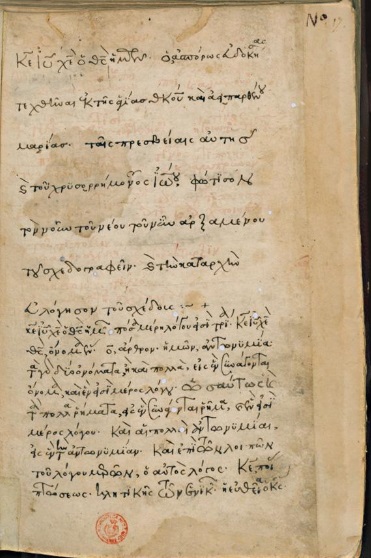

Home News & Events Study Research Members & Staff Publications Friends of the Hellenic Institute Contact Us
Manuel Moschopoulos’ Schedography
The role of grammar, fundamental in teaching a language, was stressed by Byzantine scholars and teachers on every possible occasion. The principal method used in the Byzantine school for the teaching of grammar between 11th-15th c. was what came to be known as schedography. It involved the application, through short compositions (schedē), of grammatical rules at the same time enriching the vocabulary of students. The schedography of the teacher and scholar Manuel Moschopoulos (ca. 1265-ca. 1316) became the standard method of teaching grammar, replacing its more elaborate predecessors. Known in its printed version as Peri schedōn, this work contains 22 short schedē of both secular and religious content, accompanied by brief commentaries on lexicography, orthography, grammar, morphology, syntax and etymology.
Moschopoulos’ schedography prevailed not only in his own time, but also in the centuries that followed. It was widely used by teachers and students two centuries or more after Moschopoulos’ death. Its wide-spread dissemination is testified by the large number of manuscripts, preserved in major libraries in Europe. The Peri schedōn, along with the other Moschopoulean manual of grammar, the Erōtēmata Grammatica (Milan, 1493) ― both set out in the popular form of questions and answers ― became the basis for the teaching of orthography, grammar and syntax not only in Byzantine schools but also among Western humanists for example, the Italian scholar and humanist Giovanni Tortelli (1400-1466), who contributed substantially to the foundation of the Vatican Library. Tortelli’s Grammar contains sections of the Moschopoulean schedography and Erōtēmata, and in his De orthographia, following Moschopoulos’ example, he examined the etymology and meaning of words using passages from ancient authors. Moreover, a number of codices preserving Moschopoulos’ schedography, are linked with schools in the West. Explanations, glosses and scholia added by Western humanists, teachers or students show the way Moschopoulos’ schedography was used and adjusted to their needs.
The editio princeps of a version of the Peri schedōn by Robert Stephanus, under the title Manuelis Moschopuli, De ratione examinandae orationis libellus. Ex bibliotheca regia (Paris, 1545), was based on a single, so far unidentified codex of the National Library of France in Paris. However, more versions of the text, in terms of structure order and number of the schedē, survive in a large number of manuscripts. This on-going research project aims at producing the first complete critical edition of this important text, exploring its manuscript tradition in an attempt to reconstruct the stemma codicum.It will further explore, through the quotations Moschopoulos used as examples to explain grammatical rules, the use of the classical, post-classical and Byzantine grammatical traditions adapted to the contemporary needs of the students as well as the reception of pagan and Christian authors, including Homer, Hesiod, Pindar, Sophocles, Euripides, Aristophanes, Plato, Aristotle, Theokritos, Philostratos, Synesios, Lucian, John Chrysostom, Basil of Caesarea and Gregory of Nazianzus.
The resulting critical edition will enable scholars to assess more fully Moschopoulos’ work and its place in Byzantine education, shedding more light on the Byzantine educational system, and on the influence and use of this important text by Western humanists.
Funded by the Hellenic Institute, the research is conducted by Dr Fevronia Nousia, Lecturer in Byzantine Philology at the University of Patras, under the guidance of Dr Charalambos Dendrinos.
For further information on the project please contact Dr Fevronia Nousia, Department of Philology, University of Patras, Patras, Greece; or Dr Charalambos Dendrinos, Director, The Hellenic Institute.

